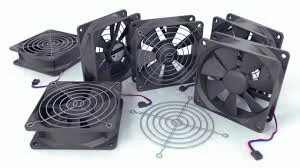When I first had trouble with my AC, the technician told me it wasn’t the compressor, it was the AC fan. That moment helped me realize how vital the fan in a unit really is. It doesn’t just blow air; it plays a big part in the cooling process. Whether you’re using older air conditioners or newer models, the AC system fan pushes cool air through your home, making sure you feel that much-needed comfort during summer.
Over the years, I’ve also seen how proper cooling practices like cleaning or replacing the ac fans can make your entire HVAC system work better. Some people call it a fan with ac, others a fan ac, but in the end, it’s a small part with a big job. If your air conditioning isn’t cooling right, always check the fan, it’s often the silent hero behind a chilled room.
What is an AC Fan?
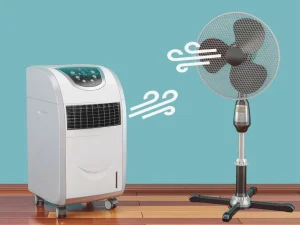
When I first opened up my old window unit, I noticed how the ac fan quietly sat behind the front grille, spinning with purpose. The fan ac isn’t just a random part inside your system, it’s what keeps the cooling process running smoothly. It pulls in warm air, pushes it across the cold coils, and sends out refreshingly cool air into your room.
Buy Now
What really surprised me was how the ac electric fan motor plays such a huge role. This motor drives the fan blades and determines how efficient your personal cooling experience will be.
A well-maintained fan not only cools faster but also lowers energy consumption, which I learned the hard way when my power bill jumped after ignoring a worn-out motor. Keeping your AC’s fan in top shape means you get better comfort, and you use less electricity too. At DeepDivePicks, we don’t just list products — we dive deep into features, performance, and real-user feedback.
Understanding the AC Fan and How It Works
When I first learned how my fan in the AC unit worked, I realized it played a bigger role than just blowing air. The AC fan helps distribute cool air across the room, supporting the overall cooling approach of the system. While many people think it’s only active when the air conditioner is cooling, its functionality depends on your thermostat settings.
One thing I always check during hot days is whether my AC fan mode is set to on or auto. In fan mode in AC, the unit circulates air even when it’s not actively cooling, which can help balance the temperature throughout the space. However, leaving it on all the time might not be energy efficient.
From personal experience, using auto mode with the right thermostat settings keeps my home comfortable while saving on bills. Understanding this simple function can really make a difference in how your AC performs year-round.
Components of an AC Fan
From years of dealing with air conditioners, I’ve come to appreciate how every little part inside the AC unit fan plays a big role in keeping the system running smoothly. At the heart of it is the ac fan motor, which powers the entire setup.
This fan motor is built to withstand constant use and works together with the ac fan capacitor to start and keep the motor spinning effectively. Without the capacitor, the motor wouldn’t even budge. The real movement you see is thanks to the ac fan blade, which pushes air through the system.
Whether you’re using a blower fan for an ac unit or a simpler setup, the ac motor fan keeps the airflow steady. One common issue I’ve noticed during repairs is damage to the fan blade, often due to debris or wear. The fan motor in ac must be in perfect sync with the other parts to maintain cooling efficiency, and any imbalance can quickly affect the whole unit.
When it comes to cooling a room, choosing the right AC fan makes a big difference. I’ve tried several types in different home setups, and each serves a unique purpose depending on space and need. One of my personal favorites is the ac tower fan, it’s slim, powerful, and perfect for indoor fans in bedrooms or living rooms.
Buy Now
For small areas or on-the-go comfort, a mini ac fan or portable ac fan works wonders. I once used a portable fan ac during a power outage, and it surprisingly held up well for hours. If your HVAC needs a boost, installing an ac booster fan or a dc2 ac fan near vents can help improve airflow.
I noticed this especially in older houses where airflow is uneven. For cooling that feels almost like a real air conditioner, some fans that cool like ac deliver icy breezes, especially when combined with ice packs or water tanks, like in an ac cooler fan.
Ceiling fans are classic, and an ac ceiling fan remains a top choice for wide, steady air circulation. In tighter areas or for silent airflow, the ac infinity fan or the highly efficient ac infinity vent fan can be installed to optimize airflow without taking up space.
How Air Conditioners Work
As a personal experience of a person who once faced both the home and office cooling systems, I have come to the conclusion that an AC unit fan contributes a significant amount towards the overall cooling process. When the air conditioning system becomes functional, the compressor will do its work and move the refrigerant along the coils to draw away the heat.
But the failure of the fan on an air conditioning unit to turn is the one that can be a true indication of trouble. In its absence, the hot air flow will not be displaced even though the unit is positioned, hence violating the cadence of conventional cooling activities.
I have witnessed situations where fans in the AC unit are not moving and as a result, the entire unit goes off or blows hot air back indoors. This is because it is the duty of the AC unit fan to blow away the hot air and allow the cool air to circulate in the right manner.
Thus when the fan on the AC is not turning, it disrupts the cooling system thus putting a strain on the compressor causing damage. Maintenance of your air conditioning system would imply constant attention to the fan, that little component, with a big responsibility.
Basic Principles of Air Conditioning
Knowledge of the impact that the AC fan stopped working has on the whole system made me aware to the extent to which it is important both in terms of cooling and comfort. Air conditioner can not move air over the coils properly without your AC fan turning on.
This causes unbalanced temperature, and this makes the climate indoors appear hotter than it is. I had a similar first-hand experience in the middle of a heatwave, and it disrupted all of my plans concerning cooling. In a case where the AC fan has stopped spinning, the AC does not easily push cool air into the room hence leading to overworking and energy wastage by the system.
The common problems can be avoided by regular maintenance, and I know that even minor symptoms of fan problems should not be overlooked. The understanding of the way these sections interact will make you smarter in the cooling and efficiency of your home.
Role of the Fan Motor
I also understood how significant it is in the functioning of the system because of having to replace the fan motor of one of the units in my previous apartment. The fan motor assists in blowing air over the condenser coils in order to discharge the heat in your home.
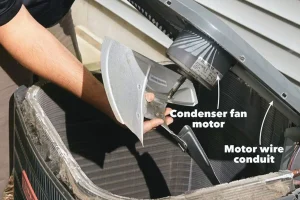
An operating AC condenser fan motor will ensure that your AC is cooling as well as regulating the use of energy. If this motor stops working, your system can overheat, leading to more electricity use and higher bills. The ac unit condenser fan motor spins the fan blades that push hot air out of the unit.
Buy Now
I once delayed replacing mine and saw a clear spike in my energy demand. A quick switch to a replacement fan motor for ac made a huge difference. If your fan seems slow or noisy, it might be time to consider a condenser fan motor for ac unit to keep your AC efficient and your room cool.
How AC Fans Improve Indoor Air Quality
When I first started learning about indoor fans, I never imagined how much they could affect air quality. Many people think it’s just about staying cool, but a good ac vent fan actually helps circulate clean air through your home. If the air isn’t moving well, dust and allergens can build up, making it harder to breathe, especially for people with allergies.
That’s where a quality ac duct fan booster can make a real difference. It improves airflow, pushing conditioned air further into your rooms, which helps reduce hot or cold spots and improves human thermal comfort. I once installed a small ac duct fan booster in a friend’s older home, and within days, the stuffy feeling in certain rooms disappeared.
Not only did the home feel more comfortable, but they also noticed fewer breathing issues. Better airflow supports sustainability too, since it helps the AC system run more efficiently. Clean, moving air contributes to your health and saves energy, which is a win for both you and the planet.
Fan Speed and Efficiency
When I first adjusted my AC fan speed during a particularly hot summer, I realized how much of a difference it made in both comfort and energy savings. Playing with the fan speed settings helped me find a perfect balance between cooling and cost. A higher fan speed may cool your space faster, but it also increases electricity demand, which leads to higher energy bills.
On the other hand, using the right fan speed settings can improve energy efficiency without making the room feel less comfortable. Once, when the fan not spinning on a unit issue occurred at my place, I noticed my utility costs shot up because the system worked harder than it needed to. That moment taught me how vital it is to keep the fan speed in check, not only for performance but also for reducing energy bills in the long run.
Understanding Fan Speed Settings
When I began experimenting with my thermostat levels, I was at a loss of knowing whether I should leave the ac fan on, or at auto. Having tried both of them, I discovered that the fan mode in ac actually influences the level to which the room will be cool and comfortable.
In case the fan is running, the air will continue circulating even when the compressor is not running therefore this will assist in cooling me during humid days. It consumed a little more energy though. The change to auto meant that I would only have the fan running when the cooling system was engaged, and this is among the most effective ways toward saving energy so far.
Once, I noticed my ac going into fan only mode without cooling. It turned out my system needed a quick reset and some filter cleaning. Since then, I’ve paid more attention to how the fan speed is set and how it impacts airflow. Changing the fan mode in ac gave me better control over air circulation and really helped balance temperature throughout the house.
How Fan Speed Affects Cooling?
When I first dealt with an ac not cooling but fan running issue during a hot summer, I realized how important fan speed truly is. Many people think turning the fan on high will instantly cool the room faster, but that’s not always the case.
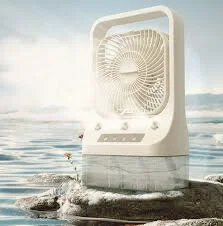
The fan speed directly impacts cooling efficiency because if the air moves too fast, it doesn’t have enough time to absorb cool air from the coils.
In some situations, especially with a split AC not cooling but the fan is running, the problem often lies in a mismatch between the compressor function and fan speed.
I’ve seen that incorrect speed settings can also affect your thermal comfort, making the room feel unevenly cool. Plus, running the AC unit fan but not cooling at the wrong speed increases electricity consumption without giving the right cooling.
Buy Now
Balancing the fan speed with the temperature and room size is key. Once I adjusted my AC settings properly, not only did my room become cooler and more comfortable, but I also noticed a slight drop in my power bill.
Tips for Optimizing Fan Speed
When it comes to getting the most out of your AC fan, knowing when to use fan mode in AC can make a big difference. From my own experience, I’ve noticed that using fan mode during cooler evenings helps maintain comfort without overusing the compressor. This simple switch can lead to better cooling practices and noticeable savings over time.
A common question people ask is, should AC fans be on or auto? Based on what I’ve seen in homes and apartments, the AC fan on auto or on setting can really affect your energy bill. Using the auto setting allows the system to run only when needed, which aligns well with smart energy-saving tips.
However, if you want constant airflow for even temperatures, turning the fan on might suit your needs better. Balancing these options depending on the season and indoor conditions can help optimize performance and comfort.
Choosing the Right AC Fan for Your HVAC System
When I first upgraded my HVAC system, I didn’t realize how big a role the fan for a unit played in overall performance. Picking the right one isn’t just about size or speed, it’s about enhancing comfort level, saving on bills, and ensuring reliable operation.
If your fan is noisy, slow, or not running at all, you might need an ac fan motor replacement. I’ve had to replace mine once, and I learned that waiting too long can affect the energy efficiency of the whole system.
One thing that caught me off guard was the ac fan motor cost. It varies a lot depending on the brand and type, but investing in a high-quality motor means smoother air flow and better personal cooling during hot days. If your current setup isn’t keeping your rooms evenly cool, it’s likely the wrong fan type for your system. Choose wisely, it’s a small part with a big impact.
How AC Fan Motors Affect Your Energy Bills
When thinking about a fan motor replacement cost, it’s important to look at more than just the price of parts. From my own experience helping friends fix their HVAC systems, the real surprise often comes from the hidden charges.
A proper cost analysis should include not just labor, but how long the system has been running and how much wear the motor has taken. Over time, an old motor can increase energy consumption, making your AC work harder than it should. That’s when your energy bills start to climb.
Many people only realize the cost to replace a fan motor on a unit after they’ve already had a technician over. I always tell homeowners to compare quotes and check if a repair would make a difference or if replacement is the better call.
A new motor not only works better, it also helps reduce energy consumption, keeping energy bills in check in the long run. If you’re unsure, do a proper cost analysis with a professional to weigh out short-term vs long-term savings.
Choosing Between Ductless and Ducted HVAC Systems
| Aspect | Ducted System | Ductless System |
|---|---|---|
| Airflow Method | Air moves through a network of ducts. | No ducts; air flows directly from the unit into the room. |
| Airflow Challenges | May struggle to push air to farther rooms. | Airflow can be less evenly distributed in larger spaces. |
| Solution for Airflow | Use an AC duct fan booster to enhance airflow in under-cooled areas. | Use an AC vent fan to redirect or boost airflow where needed. |
| Best For | Homes with existing ductwork. | Homes without ducts or with limited space for duct installation. |
| Comfort & Efficiency Tip | Smart airflow management ensures better comfort and energy savings. | Smart airflow management ensures better comfort and energy savings. |
Where to Shop for Air Conditioners
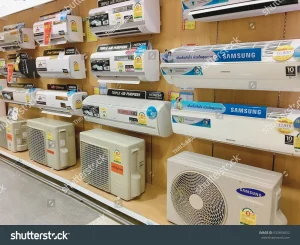
When looking for the right ac fan, I usually check big-name retailers first, especially those known for affordable and wide selections. One place I trust is Walmart.
Their marketing strategy often includes bundle deals and seasonal discounts, making it a smart choice for ac unit purchasing.
Whether you’re shopping in-store or online, Walmart fans and ac options are easy to explore and often backed by reviews that help you choose faster. If you’re considering a window fan ac unit, Walmart has plenty of those too. I’ve bought one myself for a small guest room, and it worked surprisingly well during hot months.
Buy Now
These units are perfect for smaller spaces and are budget-friendly. Shopping at reliable businesses like Walmart ensures you get warranty coverage and customer support if needed. The variety and ease make the ac fan Walmart experience convenient and trustworthy.
What to Do When Your AC Fan Stops Working
- A sudden AC fan failure can be frustrating, especially during hot weather when cooling is essential.
- Don’t panic many issues are minor. In my experience, people often assume the worst, but simple troubleshooting can solve the problem.
- Check the fan on the outdoor AC unit, if it’s not spinning, the issue might be the power supply or a tripped circuit breaker.
- Real-life example: A neighbor once thought his AC was completely broken, but it was just a tripped switch, easily fixed in seconds.
Common Issues with AC Fans
From my own experience dealing with summer heatwaves, I’ve noticed how cooling failures often begin when the outside AC fan not spinning becomes the first red flag. Many homeowners panic when the outside AC unit fan is not running but inside is, assuming the entire system is broken, but it usually points to specific common faults.
These include bad capacitors, failed motors, or even a faulty thermostat. Each of these issues can lead to serious fan breakdowns if not addressed in time. One situation I clearly remember was when a client’s AC condenser fan not spinning caused the unit to overheat and shut down.
It looked like a major failure, but the actual cause was just a burnt-out capacitor. Knowing how to spot these common faults early can prevent expensive repairs and restore cooling quickly. So, when the outside AC fan is not spinning, always start by checking power flow, capacitor condition, and fan motor performance. Ignoring these cooling failures can turn a small issue into a full system fan breakdown.
How to Set the AC for Optimal Performance?
From years of personal experience dealing with different air conditioners in varying climates, one thing is clear: knowing how to set the ac fan mode the right way makes all the difference. Many people wonder whether to keep the ac fan on or auto, but here’s what works best for comfort and savings.
Setting the ac fan mode to auto allows the fan to run only when the cooling system is on, which supports better energy-saving methods. This approach not only reduces electricity use but also gives your unit a longer life. When creating a good cooling strategy, always balance comfort with smart use. Keep the ac and fan coordinated, so they work together instead of against each other.
Combine this with optimal thermostat use by setting your thermostat a few degrees higher when you’re away and adjusting the fan mode depending on the time of day. This setup, especially in hotter months, keeps your home cool without overworking your AC. Trust me, once you apply these settings consistently, you’ll feel the difference both in your comfort and your energy bill.
Handling Serious AC Fan Motor Problems the Right Way
If your ac fan won’t turn off even after adjusting the thermostat, or your ac fan won’t turn on when it should, it’s often more than just a quick fix. I remember once thinking I could handle it myself, but I ended up making it worse. That’s when I realized that professional help saves time and prevents damage. HVAC technicians know how to spot deeper problems like wiring issues or faulty control boards that most of us would miss.
Also, when the issue is the ac fan not turning on, it could be a sign the ac fan motor replacement is needed. This job involves electrical work and the right tools, which is why it falls under serious service needs. Don’t wait too long hoping the system resets itself. From personal experience, letting a trained expert take over not only fixed the problem faster but also protected my AC unit from further damage.
DIY AC Fan Cleaning and Lubrication Guide
If your AC fan is making strange noises or not cooling as it should, a little care can make a big difference. One weekend, I decided to open up my unit and realized how important fan maintenance really is. I started by switching off the power for safe handling, then carefully removed the cover to check the fan motor for ac unit. Dust had built up around the ac motor fan, slowing it down.
With a soft brush and a vacuum, I began cleaning the inside. A clean motor runs better and quieter. I also checked the ac fan blade for any dirt or bent edges that might affect performance. A drop or two of oil in the right spot worked wonders on the motor’s movement. If your fan still acts up, a quick troubleshooting session can help spot deeper issues like worn-out parts or wiring problems. Regular upkeep saves money and keeps your AC running smoothly all summer long.
Top AC Fan Brands and Technologies
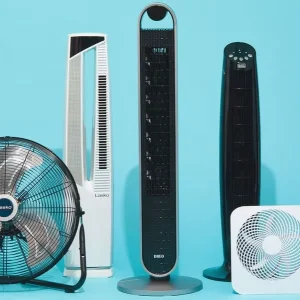
When I first upgraded my cooling system, I didn’t realize how advanced smart fans had become. Brands like Dyson and AC Infinity are changing the game.
The Dyson AC fan instantly stood out to me with its bladeless design, which felt both safe and modern. Its sleek look and remote control feature made it feel more like a luxury appliance than a typical fan.
Later, I came across AC Infinity fans, especially the AC Infinity inline fan range. These are perfect for anyone needing strong airflow in tight or ducted spaces.
Their inline fan technology is quiet but powerful ideal for people who want efficient ventilation without the noise. From my experience, AC Infinity focuses on performance and durability, while Dyson leads in design and innovation. Choosing between them depends on whether you want beauty, brains, or brute power in your AC fan.
Buy Now
Future Trends in AC Fan Technology
As someone who has tested dozens of cooling options in real-world heat, I can confidently say the rise of fans that cool like AC is no longer a far-off dream. These modern fans now use low-energy systems to deliver impressive airflow without the heavy power draw of traditional AC units. What makes them truly exciting is how they integrate with smart controls, letting users adjust settings through apps, voice assistants, or automated timers.
The shift toward sustainable tech is clearly visible in today’s market, especially as people compare fan vs AC and prioritize energy efficiency. With smart fan models entering the scene, the gap between fans and traditional air conditioning is closing fast. Many of these innovations are shaping the future HVAC landscape, where comfort meets eco-conscious design without compromise.
Conclusion
When I first started learning about cooling practices, I didn’t realize how much of a difference the right ac fan could make. Over time, I’ve noticed that using fans smartly not only improves comfort but also helps reduce energy usage in the long run. What surprised me most was how ac fan motors play such a big role they’re the heart of any fan system, and choosing the right one can lead to better airflow and quieter operation.
As someone who values sustainable cooling, I’ve gradually shifted my setup to include newer, more efficient fan models. They not only help beat the heat but also align with my goal of living more responsibly. In the end, it’s not just about staying cool but doing so in a way that’s both smart and sustainable.
FAQs
What is the fan on the AC?
The AC fan, or blower fan, moves air around your home. It cools and boosts air circulation. It doesn't cool air directly but distributes it across rooms for better comfort.
Does running an AC fan help cool a house?
Turning on the AC fan boosts airflow. It also creates a wind chill effect, helping the space feel cooler. It also improves air quality by moving air through filters, even if it doesn’t lower temperature.
What does fan mode in AC do?
In fan mode, the blower fan runs without cooling. This helps balance the temperature and keeps the air circulating. It’s useful for mild weather and for improving air quality.
What is the fan on the AC?
The AC fan, or blower fan, moves air around your home. It cools and boosts air circulation. It doesn't cool air directly but distributes it across rooms for better comfort.
Does running an AC fan help cool a house?
Turning on the AC fan boosts airflow. It also creates a wind chill effect, helping the space feel cooler. It also improves air quality by moving air through filters, even if it doesn’t lower temperature.
What does fan mode in AC do?
In fan mode, the blower fan runs without cooling. This helps balance the temperature and keeps the air circulating. It’s useful for mild weather and for improving air quality.

